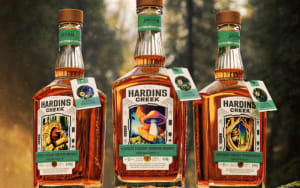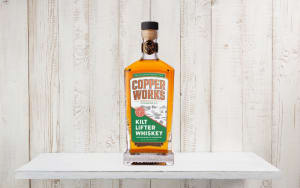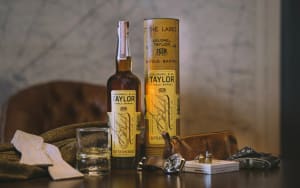Deep in the rolling hills of Clermont, Kentucky, something strange has been happening inside the James B. Beam rickhouses for the last decade and a half. The same exact mashbill – the recipe of corn, rye, and barley – was poured into barrels and then scattered across different warehouses. Some barrels went high up in nine-story Warehouse G where the temperature swings like a pendulum. Others sat low and damp in windowless Warehouse R. A few ended up right beside the creek in Warehouse W, close enough to hear the water at night. Eleven, fifteen, seventeen years later, those barrels came out tasting completely different from one another, even though the juice inside started life identical.
That’s the whole idea behind Hardin’s Creek, a bourbon series that Beam launched in 2022 to show just how much location matters – even inside the same distillery campus. Master distiller Freddie Noe, eighth generation of the Beam family, pulls the barrels himself and bottles them one warehouse at a time. The result is a lineup called The Kentucky Series, and every bottle is a one-off snapshot of time and place.
But here’s where it gets interesting for anyone who grew up cracking open a Jim Beam white label after work or on the weekends: the people at Beam decided this story was too good to tell with the usual brown-paper-and-wax look. They wanted to pull in sons, grandsons, even guys who never thought whiskey was for them. So they did something nobody expected from a 229-year-old Kentucky name – they went full fantasy.
They hired an illustrator from Germany named Max Löffler, the kind of guy who does album covers and book jackets that look like dreams you half-remember. Then they handed the lettering to a typographer named Rob Clarke and let a global branding agency called Design Bridge and Partners run the show. When the new bottles hit shelves, they didn’t look like anything else in the bourbon aisle.
Warehouse R gets a glowing purple mushroom rising out of the dark, because that rickhouse has no windows and stays wet year-round – perfect for growing wild flavors, terrible for growing actual mushrooms (they checked). Warehouse W has a beaver chewing through a barrel stave right by the water’s edge. Warehouse G, the tallest one, carries a massive owl perched on the roof, wings spread nine stories wide. Every label is packed with little details you only notice on the third or fourth pour: hidden runes, faint maps, creatures half-seen in the trees.
Marlee Bruning, the creative director who quarterbacked the project, knew exactly what she was doing.
“Loeffler’s style was a perfect match for our vision — it’s playful, but has gravitas. It feels modern, futuristic even, but also grainy and nostalgic. Most importantly, it’s immersive and transforms each label into an otherworldly portal,” she told Agency Daily.
She also made it clear this wasn’t about dumbing anything down.
“We want people, especially Gen Z and newcomers to whiskey, to feel invited to step into the world of Hardin’s Creek and help create it alongside the brand. We provide the elements of play: codes, symbols, and some translations. But it’s up to the consumer to define the game,” Bruning said.
In other words, they built the world and handed you the keys.
Look close enough and you’ll find little puzzles worked into the artwork. Some guys have already started private groups online trying to crack what the symbols mean and which warehouse might come next. There’s talk of a fox, a serpent, maybe something with antlers. Beam isn’t saying, which is half the fun.
The bourbon inside hasn’t changed – it’s still the same high-rye Beam recipe, still 110 proof, still aged longer than most bottles you’ll ever own. The seventeen-year-old from Warehouse G hits you with baking spice and old leather. The one from Warehouse R leans darker – think black cherry and wet earth. The Warehouse W expression carries a little brine on the finish, like the creek itself snuck in there somehow.
Freddie Noe tastes every barrel before it gets bottled. Only the best make the cut, and once they’re gone, that exact expression never comes back. They’re not making any more of the 17-year-old Colonel James B. Beam release that started it all in 2022, and good luck finding one now unless you’ve got four figures to spare.
So you’ve got limited-edition bourbon wearing artwork that wouldn’t look out of place on a 1970s prog-rock gatefold sleeve, made by the same family that’s been mashing corn in Kentucky since before the Civil War. It’s the kind of thing that stops you in the liquor store and makes you turn the bottle around in your hand a few times.
A lot of old-timers grumbled at first – “Beam’s gone and put cartoons on the damn bottle.” But walk into any half-decent bar these days and you’ll see those same guys with a Glencairn in one hand, phone in the other, zooming in on the label trying to figure out what the owl is staring at.
Because here’s the secret nobody expected: the fantasy stuff didn’t scare the traditional bourbon drinker away. It just gave him something new to talk about with his kid who never cared about whiskey before. Same table, two generations, one bottle, everybody happy.
And that, more than any award or score, is probably the point.
Next time you see a bottle with a mushroom, a beaver, or a nine-story owl staring back at you, grab it. Crack it open with whoever’s around. Let them study the label while you pour. By the time they figure out half the symbols, they’ll already be on their second glass – and you’ll both be part of whatever world Hardin’s Creek is building next.
Turns out all it took to bring fathers and sons back to the same bourbon was a little magic on the outside… and some of the best whiskey Beam has ever put in glass.




